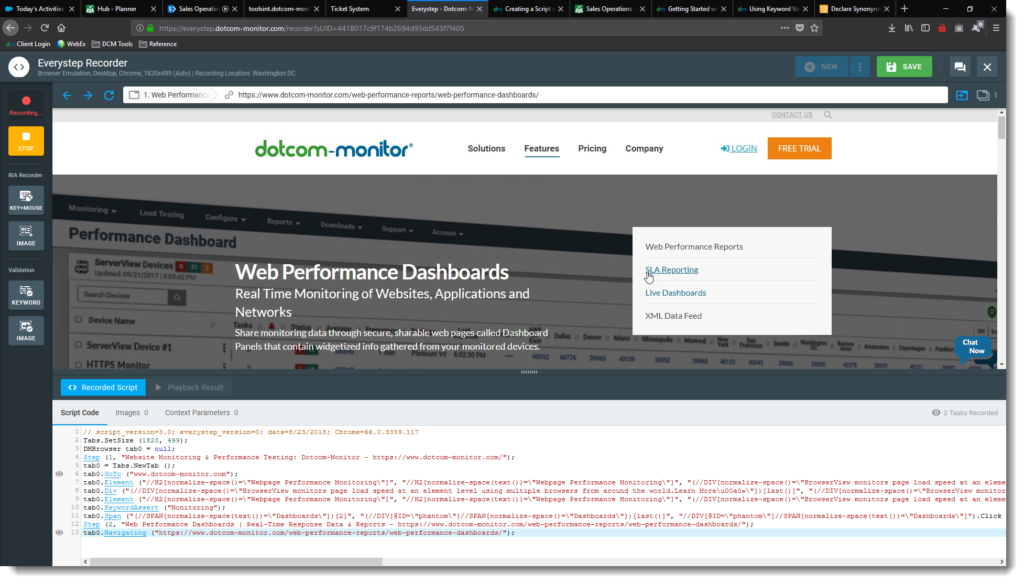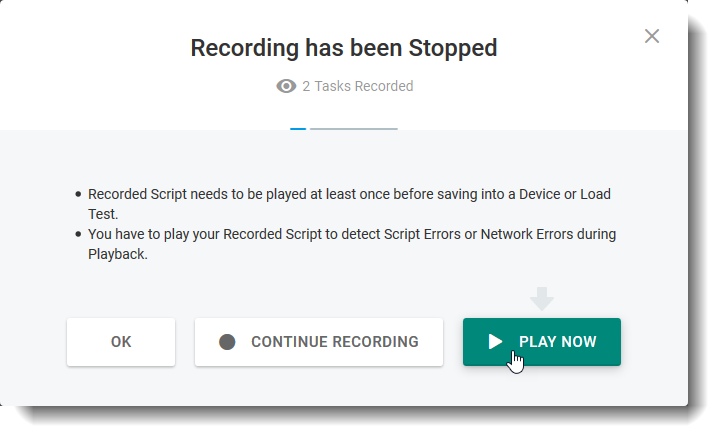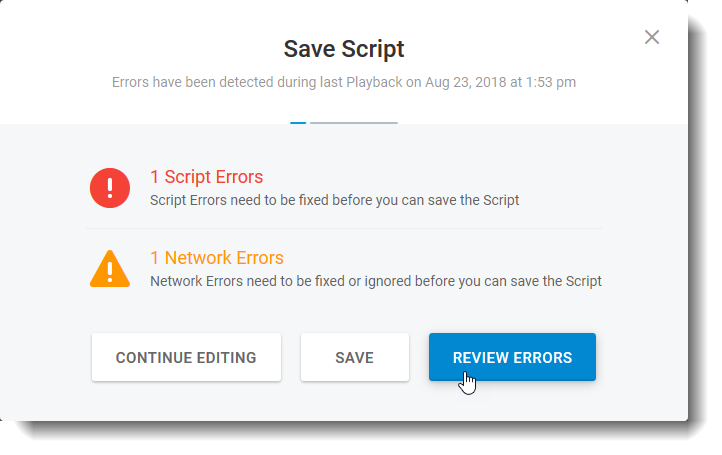The EveryStep Scripting Tool is an application that automates the recording of browser’s interactions with a website or web application. You can use a web-based or Windows desktop version of the browser recording tool. To install the desktop version, see Using EveryStep Scripting Tool Desktop.
EveryStep Scripting Tool Overview Video
How to Run Web-Based EveryStep Scripting Tool
There are two approaches to record a monitoring script with EveryStep Scripting Tool. You can start with recording a monitoring script and then save the result to a monitoring device. To use web-based EveryStep Scripting Tool, login to your Dotcom-Monitor account, then on the left sidebar select EveryStep Recorder > Web-based Application.
Alternatively, you can start by creating a web app monitoring device first:
- Click New Device on the left sidebar to add a new monitoring device.
- Under Website, select Multiple Step Process.
- In the EveryStep Recorder window, enter a starting URL.
- Specify User Device Type, Browser, Resolution To Record.
- Click Record Now and record a monitoring script in the recorder window.
Scope of Usage
EveryStep Scripting Tool is used to record scripts for:
- Web application monitoring: web application monitoring using a browser.
- Rich Internet Application (RIA) monitoring: web application monitoring that includes a need for image verification or dynamic web page elements, such as Silverlight, Flex, Flash, etc.
- Server uptime monitoring: web application monitoring using an HTTP/S (GET/POST) request process (HTTP-scripting mode is available only via EveryStep Scripting Tool Desktop).
- Load Testing: testing web applications from worldwide monitoring agent locations.
Web Applications
This is the default selection and the most commonly used function of EveryStep. Web application monitoring creates a robust script that can perform complex actions including filling out forms, interacting with multimedia, clicking on different elements of a page, checking to make sure specific text and images have loaded on the page, and much more. Read more about how scripting for web application monitoring works.
Server Uptime
Click through multiple pages, quickly creating multiple server uptime HTTP/S tasks that run, in sequence, under a single monitoring device. There are several key differences between how server uptime monitoring and web application monitoring scripts work. Download EveryStep Scripting Tool Desktop to implement this monitoring task.
Load and Stress Testing
Record the actions you would expect an average user of your website to perform. Run that script on several machines to simulate heavy loads on your website. Load testing is unique among the Dotcom-Monitor platforms in that once you record a script, you must schedule onetime tests, while other platforms perform ongoing monitoring.
EveryStep Browser Recording
Next, you perform “every step” of the web application path that a user would normally take, or that you specifically wish to verify with clicks, posts, hovers, etc. The EveryStep Recorder records each browser interaction.
Once you are done recording the script, select the Stop button from the left-hand navigation tools.
You will be prompted to replay the newly recorded script within the EveryStep Recorder to confirm the script recorded properly.
The recording is then replayed within the EveryStep Recorder to confirm that the script works.
Content Validation
Validation is a set of the functions of EveryStep Scripting Tool specific to web application monitoring tasks.
Keyword (text) validation is used to help verify that not only is the server responding to a request, but that it is serving up the proper data. Keyword validation allows you to specify keywords to be verified on a page each time the page is loaded. You can specify one keyword phrase per line. A keyword phrase contains one or more words in the same format as they appear on the page. EveryStep Scripting Tool does not allow to include multiple keywords from different locations on a website in a keyword phrase. For more information, see Using Keyword Validation.
Image Validation technology is used to take a snapshot of a reference image or area to make a per-pixel comparison. The result is a coefficient of a coincidence that is used to determine the presence of the image during monitoring. For more information, see Image Validation.
RIA Recorder
Rich Internet Application (RIA) monitoring is an add-on module of the EveryStep Scripting Tool that provides an unparalleled level of rich application monitoring capabilities. Combining our powerful Image matching technology with EveryStep Scripting Tool allows for easy creation of complex transactional analysis scripts that can actually “see” and interact with RIA technologies such as Flash, Silverlight, Java, Flex, Ajax, Shockwave, QuickTime, ActiveX, and others.
To work with dynamic RIA sites, use RIA Image and RIA Keyboard + Mouse functions.
A video demonstration of RIA capabilities and the recording process is available in the How To: Recording an RIA Script video.
Filtering Errors
If any errors are detected in the script, you will be presented with the list of the errors and prompted to choose whether you wish to filter out those errors when the script runs.
If you choose to filter out an error, EveryStep Scripting Tool will add a filtering method in the beginning of the script, similar to the following:
NetworkFilter.Deny (“http://www.example.com/FilteredOutElement.ttf“);
If the script runs into an error with this element, the error will be ignored, and the script will continue to run without reporting the error.
Saving the Script
After creating your first script, save it to the Dotcom-Monitor site by clicking Save.
Once saved, the EveryStep script is uploaded to your Dotcom-Monitor account and can be reviewed and edited in the device settings.





